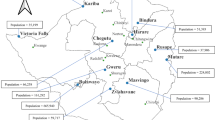Abstract
There have been two major Queensland State Government reforms: the Local Government reform of 2008 and the Water Distribution and Retail reform of 2009. These have increased the size of the community served to 897,000 and the area served to 3135 square kilometres. (These numbers were summed up from the estimated numbers in the fact sheets of the three councils. The corresponding numbers from Allconnex Water are around 850,000 people and 2800 square kilometres). The communities, previously served by four independent and separate councils, will from July 2010 be served by one entity, Allconnex Water, solely for water and waste water infrastructure. Since Allconnex Water only deals with water services, the concept of IAM as used in most other municipalities to integrate systems of other infrastructures (roads, parks, transport etc.) is not valid. In the case of Allconnex Water, however, the integration can apply to the amalgamation of different Asset Management Systems (AMS) and GIS systems used by the parent councils for the water and sewer network. This would exclude all other infrastructure systems, but include billing, meter-data collection, telemetry, SCADA and human resources. The service entities need to make great efforts in advancing IT tools to increase capacity, organisational changes, technical changes, business management, effectiveness and efficiency. While these can be achieved through IAM, the issues relating to human organisational behaviours will be a greater challenge. The most challenging of these is non-comprehensive record keeping, the ability of individuals to adapt from their basic educational and training backgrounds to working on completely automated systems and the general reluctance to accept change. These cannot be accomplished without educating the operations, maintenance and data acquisition staff, their supervisory staff and their managers of the benefits of integrating all systems seamlessly. Adequate funding would also be required to guarantee the success of the system. A one-off training session is totally insufficient; given the ongoing management problems would require continual education with suitable IT support. The full paper will address all these challenges with the dual threat posed by the aging infrastructure and work force, and the herculean efforts required in the implementation and the ongoing management of the IAM.
Access this chapter
Tax calculation will be finalised at checkout
Purchases are for personal use only
Similar content being viewed by others
Abbreviations
- AMS:
-
Asset Management System
- ANSI:
-
American National Standards Institute
- BS:
-
British Standard
- CMMS:
-
Computerised Maintenance Management Software (System)
- COSO:
-
Committee of Sponsoring Organisations of the Treadway Commission
- DIN:
-
Deutsches Institut für Normung (German Standard)
- EAM:
-
Enterprise (Engineering) Asset Management
- EAMS:
-
Enterprise Asset Management System
- ERM:
-
Enterprise Risk Management
- ERP:
-
Enterprise Resource Planning
- FARP:
-
Facility Asset Renewal Plan
- GIS:
-
Geographic Information System
- IAM:
-
The Institute of Asset Management / Integrated Asset Management in this paper
- IEC:
-
International Electro-technical Commission
- ISA:
-
International Society of Automation
- ISO:
-
International Standards Organisation
- IT:
-
Information Technology
- P&ID:
-
Piping and Instrumentation Diagram
- PFD:
-
Process Flow Diagram
- SCADA:
-
Supervisory Control and Data Acquisition
- SEQ:
-
South East Queensland
- TMP:
-
Total Management Plan
- UMD:
-
Utility Management Database
- WMS:
-
Work Management System
- WSP:
-
Water Service Provider
References
Auckland power crisis. (n.d.) (1998) Retrieved from http://en.wikipedia.org/wiki/1998_Auckland_power_crisis
Readers Guide to Queensland State Budget. (n.d.). Retrieved from http://www.budget.qld.gov.au/readers-guide/glossary.shtml
McKibben J, Davis D (n.d.) (2002) Retrieved from integration of GIS with computerized maintenance management systems (CMMS) and asset management systems. http://proceedings.esri.com/library/userconf/proc02/pap0554/p0554.htm
Plant Maintenance Resource Center. (n.d.) (2004) Retrieved from CMMS Implementation Survey Results—2004. http://www.plant-maintenance.com/articles/CMMS_survey_2004.shtml
Wienke B, Wise C. Infrastructure data management using ArcGIS and Hansen. (n.d.). Retrieved from http://proceedings.esri.com/library/userconf/proc04/docs/pap1059.pdf
Skip H, Ellen H (2007) An embeded approach to GIS and WMS integration. GITA 2007 annual conference, MundeoGeo
Heavy rain, burst pipe chaos. (n.d.). Retrieved from http://www.brisbanetimes.com.au/queensland/heavy-rain-burst-pipe-chaos-20090519-bd0n.html
GIS Integration. (n.d.). http://www.maintenanceconnection.com/mcv18/online/mc_portalintranet.htm
Total Management Planning. (n.d.). Retrieved from http://www.derm.qld.gov.au/water/regulation/pdf/guidelines/tmp/introduction.pdf
The Institute of Asset Management. (n.d.). Retrieved from http://www.theiam.org/en/about-us/index.cfm
Enterprise risk management—2004. (n.d.). Retrieved from http://www.coso.org/Publications/ERM/COSO_ERM_ExectiveSummary.pdf
Queensland Health payroll chief Janette Jones ‘moved on’ from job. (n.d.). Retrieved from http://www.news.com.au/business/business-smarts/queensland-health-payroll-chief-janette-jones-moved-on-from-job/story-e6frfm9r-1225869061600
Three new cities for SEQ. (n.d.). Retrieved from http://www.qbr.com.au/news/articleid/67784.aspx
Bligh Government to announce incentives to lure people away from southeast Queensland. (n.d.). Retrieved from http://www.couriermail.com.au/news/features/bligh-government-to-announce-incentives-to-lure-people-away-from-southeast-queensland/story-fn4z2520-1225871746351
Acknowledgments
Author wants to thank Dr. Dushy Tissainayagam, who motivated the author to prepare this paper and the Logan Water Infrastructure Manager for approving the abstract. This paper is solely the author’s view and is in no way critical of his current or future employer. The author accepts no liability for any external decisions or actions taken on the basis of this document.
Author information
Authors and Affiliations
Editor information
Editors and Affiliations
Rights and permissions
Copyright information
© 2012 Springer-Verlag London Limited
About this paper
Cite this paper
Raveenthiran, A. (2012). Human Dimensions in Integrated Asset Management. In: Mathew, J., Ma, L., Tan, A., Weijnen, M., Lee, J. (eds) Engineering Asset Management and Infrastructure Sustainability. Springer, London. https://doi.org/10.1007/978-0-85729-493-7_59
Download citation
DOI: https://doi.org/10.1007/978-0-85729-493-7_59
Published:
Publisher Name: Springer, London
Print ISBN: 978-0-85729-301-5
Online ISBN: 978-0-85729-493-7
eBook Packages: EngineeringEngineering (R0)




